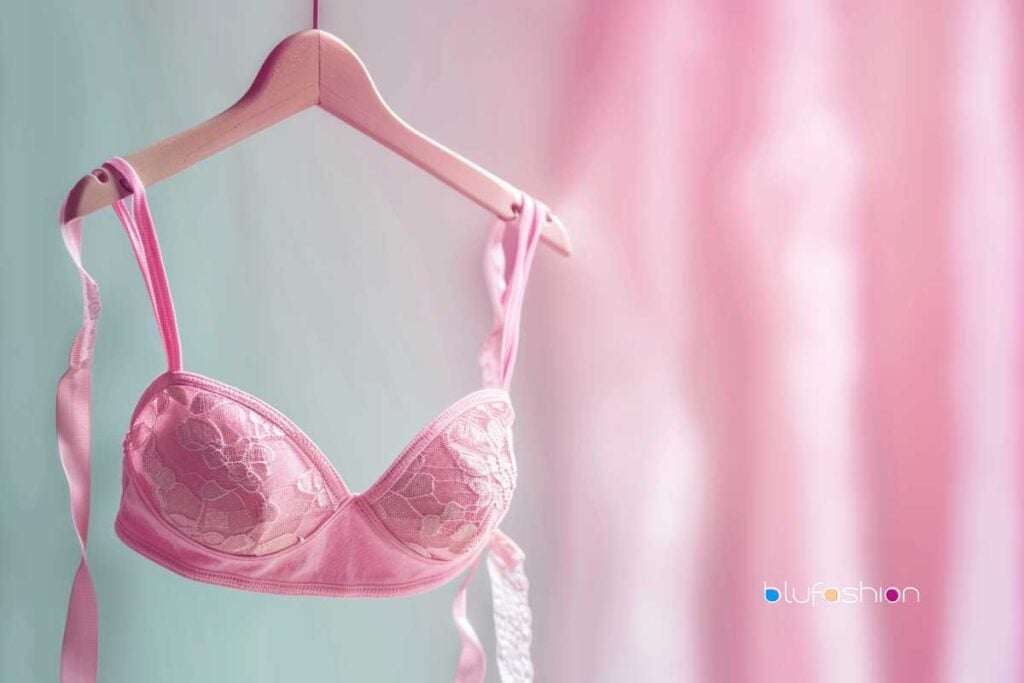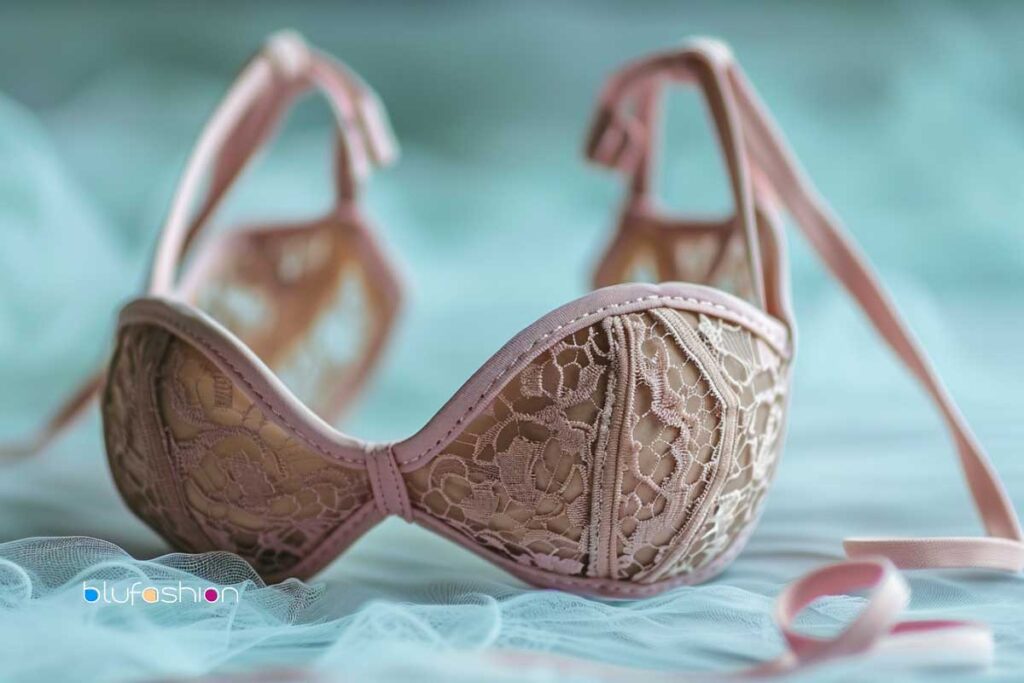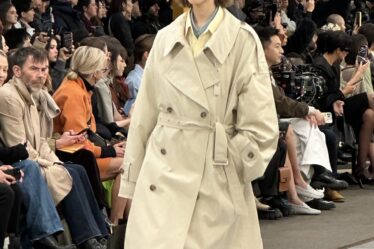
Have you every wondered what the number and letter of your bra size really mean? You’re not alone. It’s a sizing method that has been in use for years, and has gone through several changes. I started bra fitting in 2005. I have years of experience decoding bra sizes for thousands of happy clients. I’m sharing my favorite bra sizes 101 information including:
- What does the number of my bra size mean?
- What does the letter of my bra size size?
- Is a 34B and 32C the same cup size?
- What is a “sister size”?
- Why is bra my size different from country to country?
- And more!
Get the basics on bra sizing and send me a tweet if you have a question!
Band Size

Your bra’s band size is the number portion of your bra size. For example, in a bra size 32D, the 32 is the band size.
In USA lingerie boutiques, department stores, and on bra shopping sites, band sizes range from 28 to 56. Most US bra makers create bands in the 32 to 42 range. Newer products or brands are making more sizes to fit more women.
USA band sizes come in even numbers, so you won’t find one in a 33 or 45, for example.
This number is the measurement under your bust. It’s around your rib cage and in inches, not your actual bust measurement. It is not always an exact reflection of your actual underbust measurement.
In the past, bra sizes were based on a pattern that used what’s referred to as a “plus 4” method. This is now considered a “classical bra sizing” method. In this method, you add 3, 4, or 5 inches to the actual measurement of your underbust to get your bra band size. For example, if you measured 29 inches, you would wear a band size of 32 or 34.
In recent years, the bra industry has updated band sizes. This is part of an effort to end the “plus 4” method. Bra materials have more stretch now. In this newer method, you may add 0, 1, 2, or 3 inches to your actual measurement to get your desired band size.
For example, if you measure 29 inches, you would try a 30 or 32 band size. Learn more about measuring yourself and finding your bra size.
Every lingerie company sizes their undergarments and bras differently. There is no agreed upon method or exact science. Trying on each bra and checking its fit is the best way to find comfort and support.
| Essential Insights | Explanation |
|---|---|
| Band Size Basics | The number in your bra size (e.g., “32” in “32D”) represents the band size, essential for the correct fit. |
| USA Band Size Range | Typically spans from 28 to 56, with most manufacturers focusing on the 32 to 42 range. There’s a trend towards inclusivity, with more sizes being added. |
| Even Numbers Only | Bra band sizes in the USA are in even numbers only (e.g., 32, 34, 36), meaning you won’t find odd-numbered band sizes like 33 or 45. |
Cup Size


The cup size is the letter portion of your bra size. For example, in a bra size 32D, the D is the cup size. Once again, this is not an exact reflection of your actual bust measurement.
In the USA, bra cup sizes typically range from A cup to N cup. The further the letter is in the alphabet, the larger the cup size. In other words, an N cup is larger than an M cup, which is larger than an L cup, etc.
In USA sizing, the sizes typically go like this from smallest to largest:
AAA, AA, A, B, C, D, DD, DDD, G, H, I, J, K, L, M, N
DD is larger than a D cup. And DDD is larger still. It then jumps from DDD to G. DD replaces E, and DDD replaces F. But, this is not true in all brands. Some follow a European method. Don’t confuse it with the UK method, which I’ll explain later. The European method just uses letters like A, B, C, D, E, F, G, H, etc.
While the DD is larger than the D cup, this is not true for the A cup. The cup size AA is one size smaller than an A cup, and a AAA is even smaller.
Keep in mind that every brand sizes their bras differently. Finding the right size and fit relies on trying them on. You must find what feels great and supports your bust – regardless of the tag.
| Summary Point | Details |
|---|---|
| Range of Cup Sizes in the USA | Typically A to N, with each letter representing a larger size. |
| Common Sizes Sequence | From smallest to largest: AAA, AA, A, B, C, D, DD, DDD, G, H, I, J, K, L, M, N. |
| Size Specifics | AA is smaller than A, AAA is smaller than AA. DD is larger than D, DDD is larger than DD. After DDD, sizes proceed to G, H, I, etc., skipping E and F. |
| European Sizing Convention | European brands may use a continuous alphabetical convention: A, B, C, D, E, F, G, H, etc. |
| Cup Size Measurement | The difference between bust and band size is key. Each inch difference is a cup size (e.g., 1″ = A). |
| Variability Between Brands | Sizing can vary between brands, emphasizing the importance of trying bras to ensure the right fit. |
| Band Size | The number part of the bra size (e.g., 32, 34, 36), indicating the circumference of the band around the rib cage. It should fit snugly. |
| Measuring for Bra Size | Measure under the bust for band size and over the bust for cup size to find the correct bra size. |
How Cup Size Relates to Band Size


Did you know that a 32D is smaller in the cup and the band than a 34D? It’s obvious that the 32 band is smaller than the 34 band because it’s a smaller number, but what about the cup size?
Cup size is usually found by subtracting your band size from your bust measurement. Cup size is relative to the band size, meaning it changes as the band size changes. So, a D cup is not the same size or volume in each band size.
As the band size gets larger, so does the cup volume, by one cup size. For example, a 32D is one cup size smaller than a 34D, two cup sizes smaller than a 36D, three cup sizes smaller than a 38D, etc.
For that same reason, bra sizes have “sister sizes”. These cup sizes may look different. But, the cup volume will be the same. This is because the band size is different.
For example, a 32D has the same cup volume as a 34C, or a 36B, or a 38A. The only difference is the band size (and possibly where the cups are positioned on the band.)
This can be confusing but very helpful to know, especially if you’re adjusting your bra size to get a better fit. Let’s say you are trying on a 34C bra, and the band feels a bit loose but the cup size seems ok. Instead of trying a 32C, you should try a 32D. That way, the cup volume will remain the same, and the band will be smaller.
Bra brands use different materials and fitting methods. This is one reason why you may have well-fitting bras in more than one size in your drawer.
I have several sizes! Once you get the hang of how a cup size relates to a band size, it will be much easier to get a better fit in your bra size.
| Summary Aspect | Explanation |
|---|---|
| Cup Size vs. Band Size Relationship | Cup size depends on band size. The same cup letter does not mean the same volume across different band sizes. As band size increases, so does the volume for the same cup letter. |
| Example of Cup Volume | A 32D bra has smaller cups than a 34D. A 32D shares the same cup volume as a 34C, 36B, or 38A (“sister sizes”). |
| Adjusting for Better Fit | If the band is loose but cups fit, move down a band size and up a cup size to maintain cup volume. For small cups, go up a cup size; for large cups, go down a cup size. |
| Determining Cup Size | Cup size is calculated by the difference in inches between bust and underbust measurements (e.g., 1″ difference = A cup, 2″ = B cup, etc.). |
| Practical Example | With a bust measurement of 37″ and an underbust of 34″, the difference is 3″, indicating a 34C bra size. |
| Sizing Variability | Bra sizes can differ between brands and styles. So, use measurements as a starting point. Try on various sizes for the best fit. |
| Ideal Bra Fit | The right size bra should feel snug and supportive. It should not cause discomfort or spillage. |
Sizing in Different Countries
You’ve heard me say that bra brands often size differently. I’m referring to how the actual bra will fit. Even in brands using the same sizing method, like those made in the USA, each bra or brand may fit a bit differently. This is because of manufacturing, materials, and style differences.
But some brands use a completely different sizing system. This is especially true for those in different countries.
Here are a few popular bra sizing methods:
European lingerie brands, use cup sizes that run A, B, C, D, E, F, G, etc. They do not favor the D to DD method. They also use band sizes like 65, 70, 75, 80, 85, etc. A 65 is like a 30 band in the USA. A 70 is like 32, 75 is like 34, 80 is like 36, and 85 is like 38. So, a USA 32DD would be a 70E. Examples of brands that use this method: Empriente, Prima Donna, and Marlies Dekkers.
It’s in Europe. But, brands made in France and some other European nations use similar sizes. But, the sizes are different. For example, Spain’s sizes are different. Their sizes are 80, 85, 90, etc. But, they match US sizes like this: 80 is a 30 band, 85 is 32, 90 is 34, and 95 is 36. An example is Simone Perele.
Italian lingerie brands size their bras on a 1,2,3 method. The number refers to the band size. A 1 is a 32, 2 is 34, 3 is 36, etc. They also use a A, B, C, D, E, F, G etc. cup size method. So a USA 32DD would be a 1E.
Example of a brand that uses this method: La Perla.
In Australia and New Zealand, their band sizes are 8, 10, 12, 14, etc. An 8 is a USA 30, 10 is 32, 12 is 34, etc. Cake Maternity is a brand that uses this method.
In the United Kingdom, bra sizes are completely different, mainly because of the cup size. They favor the cup sizes: A, B, C, D, DD, E, F, FF, G, GG, H, HH, J, JJ, K, KK, etc. Starting with D, each letter is “double” in size. Alarming, people also often leave out the letter “i” and jump from HH to J. Band sizes use the US or European method.
So, a USA 32DD would still be a UK 32DD. And the E cup would be slightly larger. Examples of a brands that use this method: Panache, Tutti Rouge.
Some online lingerie retailers have made charts. They help you choose your bra size in different countries. These charts vary on exactly which size matches up with another, especially when it comes to the UK and US sizes.
Bra fitters in boutiques also disagree on exactly which size corresponds to which. Let’s take the USA bra size of 32DDD. Most fitters and lingerie experts would agree that this translates to a European F cup.
In the UK sizing, however, some would say that this corresponds to an E, because it’s the next cup size after 32DD. Others believe it would correspond to the UK 32F, and the E is a “half cup size” between DD and F.
Some bras are sized with a basic size only, and no cup size. For example: Small, Medium, Large, etc. or 1, 2, 3, etc. or 32, 34, 36, etc. Usually, the cup size shown here is a B or C. Though, this is not always true. What is true, is that the bust volume of the bra will increase as the band or number size increases.
| Region/Country | Sizing Method | Band Size Conversion | Cup Size Progression | Example Brand(s) | Notes |
|---|---|---|---|---|---|
| Europe | European | 65=30 (USA), 70=32, 75=34, etc. | A, B, C, D, E, F, G, etc. | Empreinte, Prima Donna, Marlies Dekkers | Does not use the D to DD jump. |
| France (and some European nations) | French/European | 80=30 (USA), 85=32, 90=34, etc. | Follows European cup size progression | Simone Perele | Band sizes labeled differently but correspond to US sizes. |
| Italy | Italian | 1=32 (USA), 2=34, 3=36, etc. | A, B, C, D, E, F, G, etc. | La Perla | Numbered band sizes with European cup progression. |
| Australia & New Zealand | Australian/New Zealand | 8=30 (USA), 10=32, 12=34, etc. | Follows standard cup size progression | Cake Maternity | Numbered band sizes reflecting a different starting point. |
| United Kingdom | UK | Similar to US/European | A, B, C, D, DD, E, F, FF, etc. | Panache, Tutti Rouge | Uses double letters for cup sizes beyond D; excludes “I”. |
| General | Basic Size Only | – | – | – | Represents a B or C cup; the bust volume increases with band/number size. |
Additional Notes:
- USA to Europe Conversion: A USA 32DD converts to a 70E in European sizing.
- USA to UK Conversion: A USA 32DDD is generally equivalent to a UK 32E or F, with some discrepancy among experts.
- Sizing Variability: Despite charts and fitter expertise. The best fit often requires trying on many sizes and brands. This is due to differences in manufacturing and sizing methods.
- Bra Sizing Charts: Helpful for cross-country size conversion but vary in accuracy. Fitters at boutiques may have differing opinions on size correspondence. This is especially true for UK and US sizes.
Once again, trying on each bra and assessing its unique fit on your bust it key to getting the best bra size. This basic knowledge can help you shop with confidence. You can experiment with brands and sizing methods. You can find what works best for you.
More resources:
Iskra Banović is our seasoned Editor-in-Chief at Blufashion. She has been steering the website’s content and editorial direction since 2018. With a rich background in fashion design, Iskra’s expertise spans across fashion, interior design, beauty, lifestyle, travel, and culture.



